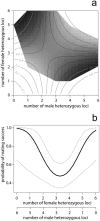MHC diversity and female age underpin reproductive success in an Australian icon; the Tasmanian Devil
- PMID: 29520077
- PMCID: PMC5843591
- DOI: 10.1038/s41598-018-20934-9
MHC diversity and female age underpin reproductive success in an Australian icon; the Tasmanian Devil
Abstract
Devil Facial Tumour Disease (DFTD), a highly contagious cancer, has decimated Tasmanian devil (Sarcophilus harrisii) numbers in the wild. To ensure its long-term survival, a captive breeding program was implemented but has not been as successful as envisaged at its launch in 2005. We therefore investigated the reproductive success of 65 captive devil pair combinations, of which 35 produced offspring (successful pairs) whereas the remaining 30 pairs, despite being observed mating, produced no offspring (unsuccessful pairs). The devils were screened at six MHC Class I-linked microsatellite loci. Our analyses revealed that younger females had a higher probability of being successful than older females. In the successful pairs we also observed a higher difference in total number of heterozygous loci, i.e. when one devil had a high total number of heterozygous loci, its partner had low numbers. Our results therefore suggest that devil reproductive success is subject to disruptive MHC selection, which to our knowledge has never been recorded in any vertebrate. In order to enhance the success of the captive breeding program the results from the present study show the importance of using young (2-year old) females as well as subjecting the devils to MHC genotyping.
Conflict of interest statement
The authors declare no competing interests.
Figures


Similar articles
-
Development of a SNP-based assay for measuring genetic diversity in the Tasmanian devil insurance population.BMC Genomics. 2015 Oct 14;16:791. doi: 10.1186/s12864-015-2020-4. BMC Genomics. 2015. PMID: 26467759 Free PMC article.
-
Molecular characterization of Cryptosporidium and Giardia from the Tasmanian devil (Sarcophilus harrisii).PLoS One. 2017 Apr 19;12(4):e0174994. doi: 10.1371/journal.pone.0174994. eCollection 2017. PLoS One. 2017. PMID: 28423030 Free PMC article.
-
Lack of genetic diversity across diverse immune genes in an endangered mammal, the Tasmanian devil (Sarcophilus harrisii).Mol Ecol. 2015 Aug;24(15):3860-72. doi: 10.1111/mec.13291. Epub 2015 Jul 17. Mol Ecol. 2015. PMID: 26119928
-
Lessons learnt from the Tasmanian devil facial tumour regarding immune function in cancer.Mamm Genome. 2018 Dec;29(11-12):731-738. doi: 10.1007/s00335-018-9782-3. Epub 2018 Sep 17. Mamm Genome. 2018. PMID: 30225648 Review.
-
Genomic insights into a contagious cancer in Tasmanian devils.Trends Genet. 2015 Sep;31(9):528-35. doi: 10.1016/j.tig.2015.05.001. Epub 2015 May 29. Trends Genet. 2015. PMID: 26027792 Review.
Cited by
-
Meta-analytic evidence that sexual selection improves population fitness.Nat Commun. 2019 May 1;10(1):2017. doi: 10.1038/s41467-019-10074-7. Nat Commun. 2019. PMID: 31043615 Free PMC article.
-
Effect of MHC and inbreeding on disassortative reproduction: A data revisit, extension and inclusion of fertilization in sand lizards.Ecol Evol. 2023 Mar 27;13(3):e9934. doi: 10.1002/ece3.9934. eCollection 2023 Mar. Ecol Evol. 2023. PMID: 36993149 Free PMC article.
-
Deciphering genetic mate choice: Not so simple in group-housed conservation breeding programs.Evol Appl. 2020 May 19;13(9):2179-2189. doi: 10.1111/eva.12981. eCollection 2020 Oct. Evol Appl. 2020. PMID: 33005217 Free PMC article.
-
Transcriptome annotation reveals minimal immunogenetic diversity among Wyoming toads, Anaxyrus baxteri.Conserv Genet. 2022 Aug;23(4):669-681. doi: 10.1007/s10592-022-01444-8. Epub 2022 Apr 28. Conserv Genet. 2022. PMID: 37090205 Free PMC article.
-
A Novel IoT-Enabled Healthcare Monitoring Framework and Improved Grey Wolf Optimization Algorithm-Based Deep Convolution Neural Network Model for Early Diagnosis of Lung Cancer.Sensors (Basel). 2023 Mar 8;23(6):2932. doi: 10.3390/s23062932. Sensors (Basel). 2023. PMID: 36991642 Free PMC article.
References
Publication types
MeSH terms
LinkOut - more resources
Full Text Sources
Other Literature Sources
Research Materials

